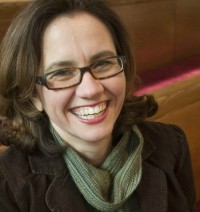Facing visions of violence
My daughter and I drove up the driveway of the Mercy Junction Justice and Peace Center to pick up my husband, Brian, from work. The Justice and Peace Center is housed in a beautifully dilapidated hundred-year-old Methodist Church, which closed. Now it’s full of artists, non-profit workers, musicians, activists and a new worshiping community in Chattanooga. Brian walked up to the car. Visibly shaken, he said, “Go home. I think I’m going to get arrested.”
He had just had a confrontation with someone in the sheriff’s department who had been off-duty, working as a security guard for the mega-church across the street. The guard drove up in a cart, and Brian asked what was going on. The guard ignored Brian, driving his cart to the other side of the parking lot. Brian thought it was because they closed their parking, and some of the mega-church people would have to walk onto the other side of the building because they were using the lot. Brian repeated his question and the Sheriff answered, “I don’t have to tell you anything!” Brian got nervous. He wasn’t worried about himself, but there had been a couple of African-American men who had been questioned without cause on their property.
The security guard yelled, “You are impeding an investigation. You will be arrested!” The security guard walked toward Brian and reached for his side, where a gun or taser would be. Brian asked for his name and badge number, but the guard refused and repeated that Brian would be arrested.
Brian wasn’t arrested or tased. Although it's still stunning that a pastor on his church's property would be in danger of arrest for no reason. A couple of days later, as we drove up to the center, Brian was still shaking a bit, and he wasn’t sure why. His fear and anger felt complex, like a trauma, but since he’s aware of his privilege as a white man, he was embarrassed to name it that.
So we began to sort out some of his history. As a child, he had known a Native American man who was shot by the police in his hometown. On a summer mission trip he hid in the back of a Philippine Jeepney as men with automatic weapons searched stopped vehicles during the 1987 coup attempt. Brian was shot at while doing work in Cabrini Green. He had often been thrown into intense situations as a peacemaking minister in Occupy confrontations with the police. And, we had to acknowledge, the #blacklivesmatter videos.
It’s always hard to know whether to watch the videos. I know that it’s a privileged position to have a choice whether to avert our eyes or not, when some people work with violence every day. But it’s still good to stop, and think about what these images are doing to us, as people.
There is no doubt that terrible images being exposed helps white people to understand how severe the problem is. Seeing the actual footage of Michael Brown with his hands up, pleading for his life, or seeing the vulturing officers circle Eric Garner and take him down as he pleads, “I can’t breathe” makes it very difficult for us to avert our eyes and pretend that everything is okay. The videos have ignited a much-needed civil rights movement.
But are other things happening to us as well?
My daughter came into the living room, and caught me crying. “What’s wrong?” she asked, as I closed my laptop. I tried to explain that I had been watching the video of Samuel DuBose. I couldn’t quite figure out what was happening, so I had seen it a couple of times, until the brutality of it struck me. How could a shooting follow such a simple exchange of niceties? How could a man take another man’s life with no thought? How have we created this culture where men to shoot with such cavalier disregard?
“Why do you watch the videos, Mom?” Calla asked with concern. She knows that I can’t tolerate violence. I turn my head at television deaths and movie shootings. I murmur, “Let me know when it’s over.”
The same question has come up with the picture of the Syrian boy. Should his tiny body, facedown, in the sand be plastered on our Facebook feeds along with the feel-good memes and pictures of kitties?
Yet, I have to force myself to watch the shaky videos of police violence and learn the force of Syrian immigration. It’s important for me to expose myself to the murder of black lives in our country, just as it’s important for me to face the history of lynching and reality of mass incarceration.
I find out most of my #blackivesmatter news from Twitter. It scrolls up, alongside celebrity gossip and promoted diet breakthroughs. The media feels disrespectful, but Twitter covers the story before the newspapers can get to it (that is, if they get to it). The videos can be consumed in the bookstore, in the grocery store, or at the playground.
I need to find a way to hold the trauma of the community in a more sacred space. I'm realizing that through these visions of violence, I need to find a ritual. As we expose ourselves to other people’s traumas, I need to find a candle to light, a flower to pluck, or some incense to burn. I need to pray a prayer of commendation.
Brian’s shaking and my tears reminded me how precious each life is. These videos affect us on a deep emotional level. They should. And just as a person’s life should have been valued, I need to respect the person’s death.






